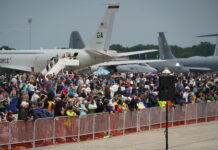At some point, every performer will be faced with a decision about whether or not to continue flying air shows. Almost five years ago, I made a presentation during the ICAS Convention in which I summarized the three-step analysis I used to make that decision for myself.
Why?
I liken air show flying to climbing hand-over-hand up a rope and ringing a bell at the top. The air show performance is the bell. Practice, expenses, burden on family and loved ones, impact to primary vocation, wrestling with the bureaucracy, and rejection are the rope.
When pondering why we fly in air shows, we need to address the fundamental reasons of why we started. Is it for the sense of accomplishment? Exhilaration or adrenalin rush? Ego gratification by performing for others? To be a “star” and set yourself apart from others?
Everybody has a different motivation for flying air shows. You can’t really make an informed decision about when it’s time to stop unless and until you’re honest with yourself about what caused you to start air show flying in the first place, and whether or not it’s still possible to ring that bell.
Evaluate
If you find yourself looking for excuses to skip practice or dreading an upcoming air show, it may be time to conduct an objective self-assessment: what are the causes and the ramifications of your “slump”?
Are you having fun? Do you still have sense of accomplishment at the conclusion of your performance? Are you maintaining an acceptable balance with your professional life, your family life and your air show life? Are you healthy? Can you still handle the physical stresses of air show flying?
Are you safe? Are you focused and sharp every time you strap in? Are the outcomes for each of your maneuvers still completely predictable and consistent? Have you become complacent or distracted? Are you taking short cuts that you wouldn’t have taken in the past?
Decide
During the late 1970s, after a disturbingly large number of fatal accidents in our business, I committed myself to a simple philosophy: out of concern for my wife and children, and to preserve my own life and business career, I would abruptly stop — cold turkey — when I first noticed that air show flying was becoming a chore or when the whole process was beginning to feel like another job.
Finally, the decision: When will I stop? Will it be when I’m not practicing adequately and routinely anymore? When I start taking shortcuts and avoiding the hard parts? When the exhilarating and rewarding moments are harder and harder to find? After I’ve scared myself badly?
For me, the development of a predetermined set of criteria made the decision to retire very straightforward. I decided early on that I would not fly air shows at less than my very best. And I knew that flying my best required that I be enthusiastic, fully engaged, attentive and disciplined.
During the course of my air show career, I‘ve taken several breaks. I took the first break as a result of pressures brought on by purchasing and owning my own business at the same time that my growing family required more and more of my time. My wife was absolutely wonderful about supporting me; she would pack the kids in the Suburban and drive all over the west coast to attend and support my performances. But I had too many balls in the air and was not practicing on a daily basis. It was becoming another job. And I wasn’t having fun. So, at the end of that season, I abruptly stopped flying air shows altogether.
By 1993, the circumstances of my business and personal life had changed. The business had been sold. The children were older. And I had developed a new enthusiasm for air show flying after watching the then-new Sukhoi fly at Abbotsford. My own self-assessment revealed that I once again had the requisite time, energy and focus to resume air show flying. And I did.
By 1999, however, my son, Russ, had become a world-class motocross competitor. My family had been overwhelmingly supportive of my flying and now it was time for me to reciprocate. I cancelled the remaining shows for the season and concentrated on helping him. This time, I actually thought I was finished.
But lo and behold, Russ was named as the U.S. Air Force Viper West F-16 Demo pilot. Neither of us could pass up the thrill of flying together at air shows. So, in 2007 and 2008, I came out of retirement…again. We enjoyed flying together at numerous large west coast shows. And the thrill of performing in the same air shows as my son was more than enough to recharge my batteries and ensure that I was having enough fun, focusing sufficiently and devoting the right amount of time to practice.
When Russ’ assignment air show demonstration career concluded at the end of 2008 air show season, it was the end for me, too. I’ve enjoyed an air show career that spanned more than 31 years. At the end of my career, I was flying with as much enthusiasm as I had at the beginning. And, if I do say so myself, the quality of my flying was actually at its best during my final year.
I don’t think I’ll ever fly in an air show again. Flying with Russ these last two years has not just been the thrill of a lifetime; it also seems to me to be the perfect ending to my air show career. But, if I do perform again, it will only be after I’ve used the same self-assessment tools that I’ve been using since I first started flying air shows in the late 1970s.








